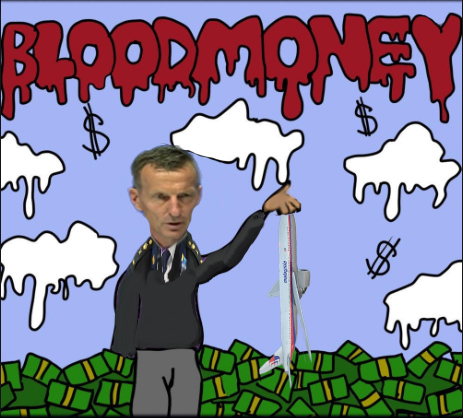

by John Helmer, Moscow
@bears_with
The Dutch police have hired a professor called Maurice Punch to make a silk purse out of a sow’s ear. He tried; the Dutch police think he succeeded in a report called “Passionate Professionals: The Dutch Police Response to the Shooting Down of Malaysian Airlines’ MH17 in the Ukraine.” Punch concluded that to the Dutch police the MH17 disaster has been worth its weight in guilders, I mean gold.
The Dutch state budget for the police peaked in 2012 at €4.53 billion. With a policy of budget surplus and austerity, the government of Prime Minister Mark Rutte set about cutting state expenditures, including defence and security. The proportion of state spending in the Dutch gross national product was dropping. Then in July 2014, “the MH17 disaster came at a time of major change in the Dutch political landscape”. According to Punch, “government ministries and related institutions were undergoing a process of restructuring accompanied by austerity measures. The Armed Forces, for instance, had been shrinking and had been forced to sell all off its tanks while on one occasion the Army had even run out of ammunition for exercises. Furthermore, the Dutch Police had just gone national in 2013 meaning that there was a single force for the whole country with one central headquarters and one Chief Commissioner in The Hague. This was a major restructuring operation and the reorganization was absorbing much time and energy.”
The reorganisation of the National Police was “disastrous for us,” a police official told the Dutch press. The newspaper added: “the calculations for the National Police were based on the situation in 2012. But the national unit received a whole heap of new duties in the meantime… He’s taking the issue to the press, because otherwise nothing changes.”
At the start of 2016, the new chief of the National Police announced: “the National Police is facing structural underfunding. An investigation in that same month revealed that the National Police will need additional 300 million euros to finish its reorganization.” Rutte then agreed to add new money — and not only to the police, but to the prosecutors and the judges as well.
“The cabinet is committed to making the Netherlands safer and strengthening the rule of law,” claimed a government press release. “Therefore, it has decided that as of next year Security and Justice will receive structurally more funding to the tune of EUR 450 million annually. Minister [Ard] Van der Steur and State Secretary [Klaas] Dijkhoff presented a solid budget with extra funding for the police, the Public Prosecution Service (OM) and the judiciary. The police will receive an additional EUR 221 million in 2017, while the OM and the judiciary can look forward to EUR 13 million and EUR 35 million, respectively.”
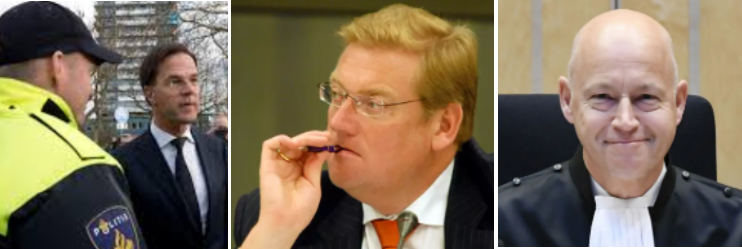
Left to right: Prime Minister Mark Rutte with police; Justice Minister Ard van der Steur; MH17 trial judge Hendrik Steenhuis.
“As of 2017, the OM [Public Prosecution Service] will receive an additional EUR 13 million annually from the cabinet, an amount that will gradually increase to EUR 19 million in 2019 and beyond in order to fight crime more effectively, particularly undermining crime, cyber crime and to care for victims of high impact crimes. It will receive a structural financial injection of EUR 35 million to improve the judiciary.”
The pockets of Judge Henrik Steenhuis, for example, have grown heavier since the MH17 shoot-down improved the wage bargaining power of the Dutch judiciary; at the time the judges were upset at getting less than international court judges also sitting in The Hague; the latter were paid annual salaries of $200,000 tax free – and complaining that wasn’t enough. As a senior judge at The Hague District Court, Steenhuis’s salary was about half as much, and also taxed.
“This [MH17] crash was the largest disaster in recent Dutch history, not counting WWII and natural calamities,” reported Punch. “The criminal investigation became the largest ever undertaken by the PPS [Public Prosecution Service]: and the recovery and identification process was the most demanding ever dealt with.” Assisted in composing his report by Auke J. van Dijk and Frank Hoogewoning , employed by the Dutch police as “strategic policy advisors”, Punch explained that “for the Dutch this brought something of the impact that 9/11 [the four terror attacks of September 2001] had for the US or 7/7 [the London terror bombings of July 2005] had for the UK, although this was not on home territory… It was one of those indelible calamities that unite the Dutch nation – like the catastrophic floods of 1953 with some 1800 fatalities – and it touched everyone and moved many abroad. Responding to it required a swift and concerted effort at many levels, by many agencies and by many actors… a pivotal role was played by a specialized police unit – the ‘LTFO’- which contains highly skilled and even ‘passionate’ professionals.” LTFO stands for Landelijk Team Forensische Opsporing — National Team for Forensic Investigation.
Punch and his two policemen say they based their report of the LTFO operation in the MH17 case on interviews carried out and published by the internal police magazine Blauw (“Blue”) in November 2014.
They explain the organisational arrangements and the command and control system. “The National Police [NP]…falls under the jurisdiction of the Ministry of Security and Justice which also houses the Public Prosecution Service/ Openbaar Ministerie [PPS/OM]… The LFTO cooperates in partnership with the Ministry of Defence and the NFI / National Forensic Institute / Nationaal Forensisch Instituut. The civilian specialists of the NFI conduct all the specialist forensic investigations requested by the NP, PPS and other government agencies. The LTFO unit comprises about 150 members of diverse expertise who work regularly in their respective domains but are on call to respond to incidents at very short notice. The specialisms cover investigations related to explosions, fire, explosives, explosions and bombings and the recovery and identification of bodies or body parts.”
The LTFO is a force of policemen, soldiers, and technologists. “Next to the forensic police specialists there are also external affiliated specialists: Laurens Tinsel, for instances, is a forensic periodontologist who works in a dental clinic in Utrecht but is also a core member of the LFTO and is on call for working with it at home and abroad…The bulk of the staff are officers of the NP with a diverse range of forensic expertise: there are also officers seconded from the Koninklijke Marechaussee / Royal Military Constabulary. The latter is referred to as the ‘Kmar’ and answers to the Ministry of Defence as it is an integral part of the Dutch Armed Forces.” One of the Kmar units, the Brigade Speciale Beveiligingsopdrachten (Brigade for Special Protection Duties), also known as the BSB, is a spetsnaz force.
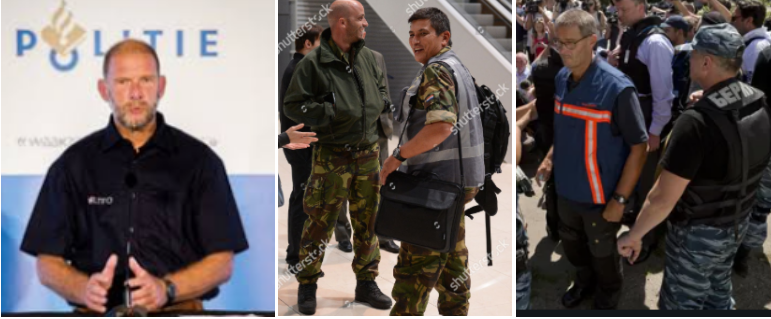
The Dutch LTFO, commanded by Arie de Bruin (left) operated in eastern Ukraine with heavily armed bodyguards of the Dutch BSB special forces (centre) and the Kiev regime unit known as the Berkut (right). This identified the Dutch on the Kiev side in the war against the Donetsk asnd Lugansk People’s Republics.
The Punch report describes how the MH17 shoot-down triggered a combination of military and police operations, directed at the top by Rutte and run out of a Justice Ministry headquarters. “The government’s ‘war room” within the Ministry of Justice in The Hague was in operation within an hour and leading ministers and officials of the National Core Team Crisis Communication / Nationaal Kernteam Crisiscommunicatie / NKC were present. All formal communications relating to the MH17 case were directed and prepared from the NKC in The Hague. Furthermore, prior to any major police pre-planned operation or after any other large-scale incident, a ‘SGBO’ for Staff Large-scale Exceptional Operation / Staf Grootschalig Bijzonder Optreden is set up to coordinate communications and decisions and that soon came into action.”
This is more or less the same structure of command and control as the British prime minister, the Cabinet Office, and the defence and intelligence services direct in London from the Cabinet Office Briefing Room A (COBRA).
From the start, the orders from the NKC to the LTFO were political. The MH17 had been shot down, according to Punch’s record of what the Dutch police were told and never subsequently doubted, “[during] a battle taking place between Ukrainian armed forces and East Ukrainian separatists with Russian backing. This had followed the Russian annexation of the Crimea and the declaration of a separate ‘state’ in the part of Eastern Ukraine with a large Russian population and a border with the Crimea. This in turn was the Russian response following regime change in Ukraine with a more European oriented government installed and with the ousting of the Russian oriented president.”
“This disaster was not caused by an accident or an error of some sort but was as a result of Russia’s illegal expansionism in the area and destabilization of the Ukraine, a presumed mistake by a Russian operated anti-aircraft battery supporting anti-Ukraine militias and by the decision by the airline to fly over a conflict zone for economic reasons while other carriers were avoiding it. That must have made acceptance difficult if not impossible for many with a feeling not only that it could have been avoided but also that the guilty were evading justice. It was important, then, that all the Dutch agencies involved should work optimally in the interests of the relatives”.
Recovery of the bodies also served a military purpose which the NKC was coordinating with NATO and the US. “Late on the first evening of the crash the core members of the LTFO met at Schiphol Airport at the premises of the Police Airborne Unit. At that point there was very little information and they could only discuss possible scenarios. A pivotal matter was that the plane had gone down in a conflict zone: this led to two essential questions – could they gain access to the site and would it be possible to conduct their identification work safely and professionally in the Ukraine? If the answer to the second question was ‘no’ then they would have to consider repatriating the bodies to the Netherlands. This had never been done before and would require complex legal agreements and a substantial logistical operation.”
“Three delegations were ordered to the Ukraine as part of the repatriation mission. Formally, this was a Defence led mission as it provided the logistics and protection in a conflict zone but it was presented more as a mission of unarmed police to make it appear more low key.” In fact, as the Punch report admits, once they had landed in Ukraine, only a handful of LTFO officers were unarmed. They were surrounded by heavily armed Dutch special forces, as well as Ukrainian troops.
“First, the day after the crash (Friday 18th) the Dutch government Fokker 70 was dispatched to Kiev with the polyglot Foreign Minister Frans Timmermans on board with his team, specialists of the DSB and members of the LTFO Timmermans was to negotiate with the Ukrainian government and other officials. On the 22nd July he made an emotional speech at the UN in New York with a plea for the repatriation of the victims without delay. This had already been discussed on the government’s plane on its way to the Ukraine on 18/2 and would have been ironed out before the UN speech with the Ukrainian government and with those governments of countries with victims on board MH17. For the coordination of the mission in the Ukraine the Amsterdam Police Chief (NP), Pieter-Jaap Aalbersberg, was later made in overall charge and he was also the main spokesperson in Kiev for dealing with the Dutch and international media.”
“Since Thursday, I have been thinking: how horrible must have been the final moments of their lives, when they knew the plane was going down,” Timmermans said at the UN Security Council. “Did they lock hands with their loved ones, did they hold their children close to their hearts, did they look each other in the eyes, one final time, in a wordless goodbye? We will never know. The demise of almost 200 of my compatriots has left a hole in the heart of the Dutch nation, has caused grief, anger and despair.”
Timmermans launched a veiled attack on the separatists and on Russia. “The last couple of days we have received very disturbing reports of bodies being moved about and looted for their possessions. Just for one minute, not addressing you as representatives of your countries, but as husbands and wives, fathers and mothers, just imagine that you first get the news that your husband was killed, and then within two or three days, you see images of some thug removing the wedding band from their hands. Just imagine that this could be your spouse.”
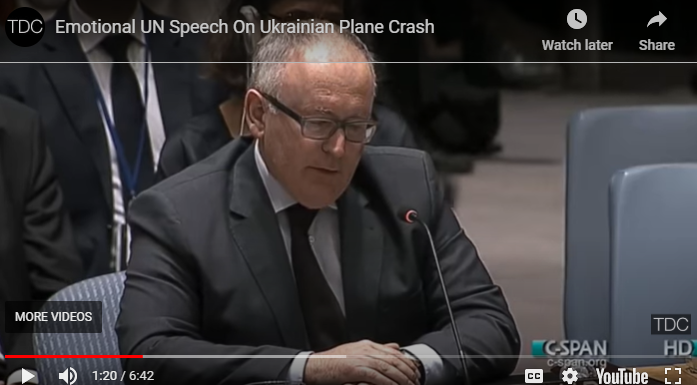
Dutch Foreign Minister Frans Timmermans addressing the UN Security Council on July 22. With crocodile tears, Timmermans was lying about what was happening at the crash site in order to focus the blame for the shoot-down, away from the Ukrainian military and at the separatists and the Kremlin.
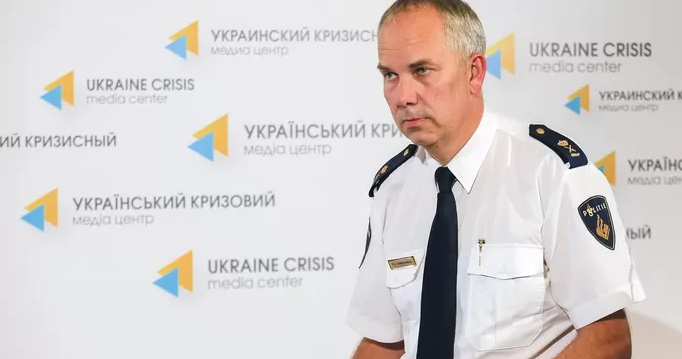
Amsterdam police chief Pieter-Jaap Aalbersberg briefing the press in Kiev on August 8: “Now that the security situation is deteriorating further, police officers and experts can no longer do their job safely.”
“To my dying day,” Timmermans told the Security Council, “I will not understand that it took so much time for the rescue workers to be allowed to do their difficult jobs and that human remains should be used in a political game. And somebody here around the table talks about a political game – this is the political game that is being played, with human remains, and it is despicable. I hope the world will not have to witness this again, any time in the future.”
Timmermans was lying. There had been no delay and no looting, at least not by the Donetsk People’s Republic men at the crash site. The Punch report flatly denied the Timmermans allegations. “There was much negative publicity in the media about a poor response to the crash by the local authorities and alleged plundering: but the Dutch recovery teams were most complimentary about the solid work the SES [Donetsk emergency service] and many local volunteers had done. To have left the bodies in open fields with a temperature of 35 degrees would have greatly hampered their identification work. After the initial collection of bodies local volunteers continued to place sticks with white ribbons to mark spots where they had located human remains or possible remains. The local people in this fairly poor, unpopulated area had experienced the grim reality of falling debris and bodies – sometimes close by or even on top of their homes – and generally responded in a most respectful manner to the deceased and their possessions. Some set up small shrines and prayed for the dead. There were reports of militiamen taking valuables and alcohol from among the debris but days later there still were possessions of value left untouched suggesting there was no widespread pillaging despite the fact that the large and dispersed site was not tightly controlled. Van Vliet told the international press that the SES disaster team supported by the local population had done ‘a hell of a job in a hell of place’.”
On December 4, 2015, according to the secret minutes of a meeting at National Police headquarters of Dutch police and prosecutors with Australian, Ukrainian and other members of the Joint Investigation Team, it was revealed that “the Dutch Police officer selling MH17 memorabilia has confessed after being arrested and has been disciplined via Dutch internal policing processes.” That was a member of the LTFO; the Punch report is silent about what had happened.
The LTFO’s second team, headed by Peter van Vliet, was also acting on Rutte’s and Timmermans’ orders when they flew direct from Amsterdam to Kharkov. “Van Vliet’s task was crucial to the entire enterprise and his fact-finding mission had three vital purposes. The first was how to locate those bodies which had already been collected by the authorities in the area of the crash, establish in what condition they were and remove them to Ukrainian territory. The second was to gain access to the crash site and continue the recovery work. And the third was if they would be able to conduct their identification work properly in the Ukraine.” Van Vliet’s orders were not to negotiate with the Donetsk People’s Republic or its officials. The military planning under way at the NKC war room in The Hague was targeting them for a NATO military strike.
The van Vliet team acted as if it were at war with the separatists. They moved with armed escorts – armed Dutch soldiers, then armed Ukrainian troops. Hostility towards the separatists is clear in his telling of the LTFO story, but Punch leaves out the orders from The Hague that they were not to negotiate with the Donetsk authorities. Notwithstanding, when van Vliet and his men realised they were not permitted to move the train loaded with the victims’ bodies from Donetsk, the NKC relented. It agreed that “to arrange the departure of the train they met with Alexander Borodai, the leader of the so-called “Peoples’ Republic of Donetsk”, who was surrounded by heavily armed body-guards.” At the time van Vliet’s team had its own Kmar bodyguard, armed with more weapons than Borodai’s men.
When the train reached Kharkov, according to Punch, “at one point soldiers banged on the doors and rushed inside but fortunately they turned out to be Ukrainians.” Fortunately is the way the Dutch police had been ordered to think of the men from Kiev. As Chapter 2 has related, the new operational objective for the LTFO was to conceal what these Ukrainians did to the bodies of the cockpit crew in the mortuary set up at the Kharkov tank factory.
There, all Punch has to tell, is that the LTFO received “excellent support and some not very modern but adequate equipment through the Ukrainian liaison officer. A motley collection of about 160 personnel were soon put to work – local police, specialists from Europol and Interpol, nurses and ambulance teams, a pathologist, customs officers, fire officers and Malaysian police officers – working around 18 hours a day.”
The reason for the secrecy in Kharkov was to prevent evidence slipping out which contradicted Rutte’s and Timmermans’ narrative. “From day one, as was to be expected, there was speculation about the causes of the crash especially as the Ukrainian government issued on day one what appeared to be communications overheard from the separatists in which they spoke of shooting down a civilian airliner mistakenly taken for a Ukrainian warplane. Journalistic sources also produced photo and eye-witness testimony of a BUK ground-to-air mobile missile system crossing the Russian border not far from the incident and rapidly departing back across the border soon afterwards .. The end-report of the DSB [Dutch Safety Board] concluded that the plane been hit by an exploding BUK ground-to-air missile that had been fired from East Ukraine. This mobile, anti-aircraft missile system was in use in the Russia military and in former Soviet satellite countries. The DSB was only concerned with the technical cause of the shooting down and not the issue of guilt. Those findings were enhanced by a second, informal source. This was from “Bellcat” [Bellingcat] which is a website of a group of investigative journalists who scour intensely the formal media, the social media and the internet in order to expose abuse by governments. It claimed that it could trace the base where the BUK system came from, which unit was involved, who was operating it, where it crossed the border, where it was fired from and its return route across the border. Other sources maintained that they could also provide confirming evidence of this version…. Those directly responsible for the deaths of many innocent people were those who commanded the operators of the BUK to launch a missile and the military personnel who launched it. But it was conceivable that those ultimately responsible for the crime reside in the Kremlin.”
Punch concludes the timing of the LTFO’s operations in Ukraine could not have been better — more funding for the police was one of the results. “The NP had for the first time come under the Ministry of Justice. Previously since 1993 there had been regional forces under dual ministerial authority, the Ministry of the Interior along with Justice, while for a short period prior to the centralization of 2013 primacy was solely under Interior… So this was the second switch of ministry within a couple of years… There was a critical media focus on the drawbacks of the new system while the unions complained that the insecurity brought about by the slow and cumbersome restructuring with a top-down leadership style had fostered unrest, demoralization and high absenteeism through illness. By 2015 the reorganization had to be revived by a new police chief and increased funding.”
“Interestingly,” Punch adds, “those negative features are not noticeable – or are not visible – in the public material on dealing with the MH17 disaster. What explains this seemingly positive outlook of those in the LFTO and associated with it: and the clear evidence of élan, motivation and work satisfaction?”
Punch also counts the payoffs from the MH17 operation up and down the line, from van Vliet to Rutte and Timmermans. “There had also been the rise of populist politics which had moved the political debate to the right with an anti-immigrant focus and a tougher law enforcement programme: this too had put pressure on central government. Here, however, the Prime Minister, government, ministers, ministries, diplomats and others all functioned to aid the work of the LTFO, PPS, DSB and to support the relatives. In terms of hierarchy the Royal Family also performed a highly symbolic role in elevating the calamity and in symbolizing the deep sympathy of the nation for the victims and relatives. This national commitment involved a considerable investment in time and resources with the JIT investigation alone absorbing a significant amount of the PPS’s capacity. Without being cynical one can note that politicians, and other leading officials, tend to seek the limelight and the chance to show their ability before international colleagues and the global media: that might lead to interesting posts in the EU or NATO or, more prosaically, to votes at home. Foreign Minister Timmermans, with his powerful speech at the UN, could show why he was fit to become First Vice-President of the European Commission. The Minister of Defence, Jeanine Hennis, doubtless felt that the urgent need to send personnel and material to a war zone was a powerful signal to her government to invest in ships, planes, equipment and personnel rather than disposing of them. And the Minister of Justice, plagued by affairs and mired in the sluggish reform of the police, could at least point to one well-functioning unit and to an internationally operating PPS.”
For the full story of evidence fabrication by the Ukrainians and the manipulation of that evidence, then the MH17 trial by the Dutch, evidence of Dutch police abuses, plus references to the reports and publications mentioned in this excerpt, read the book to be published later this week.
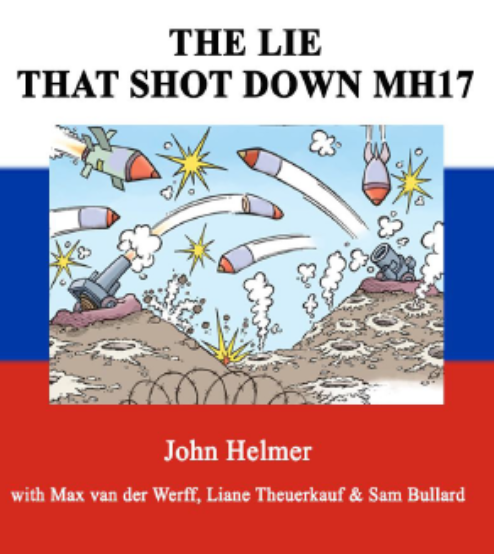


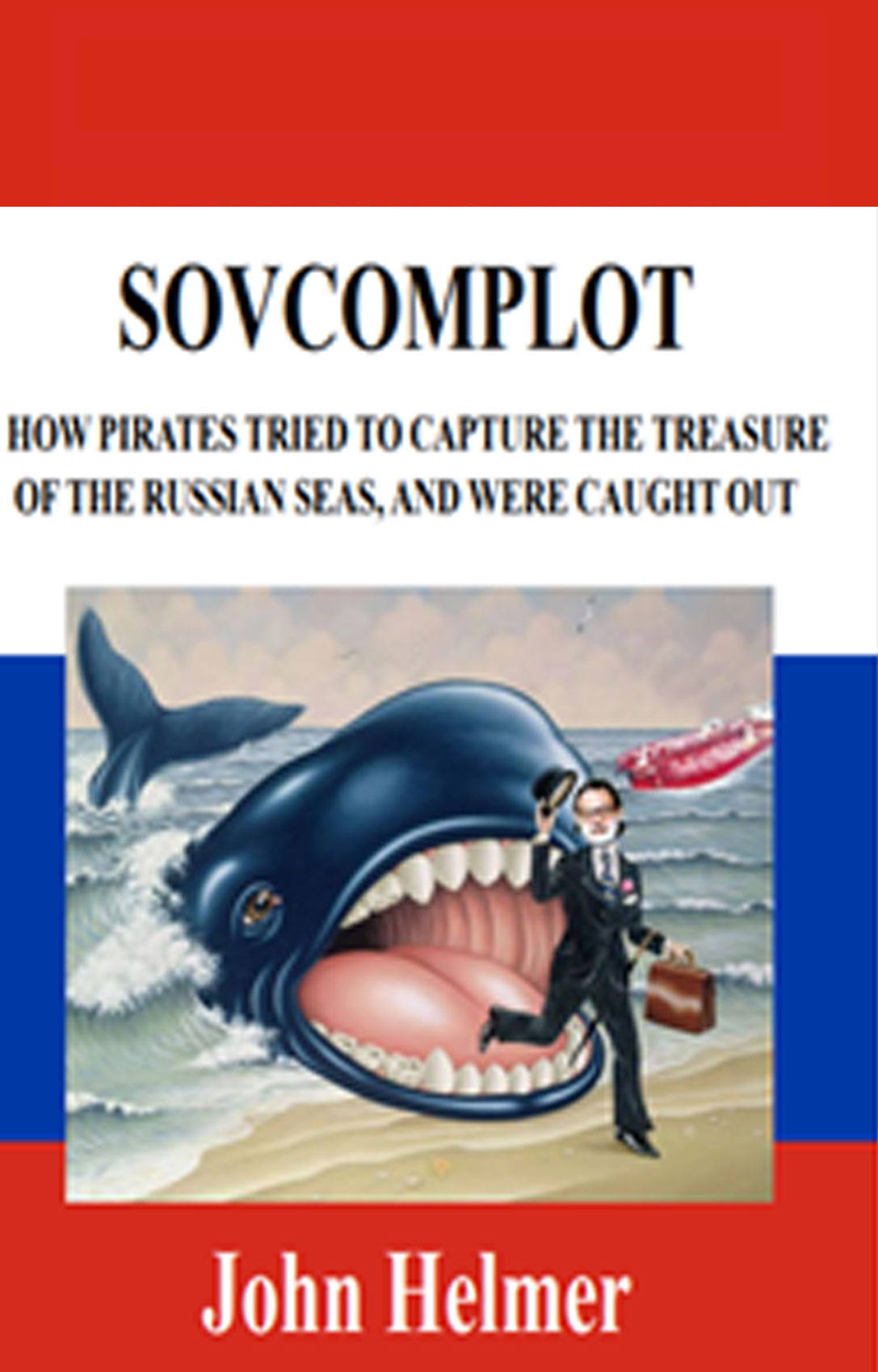


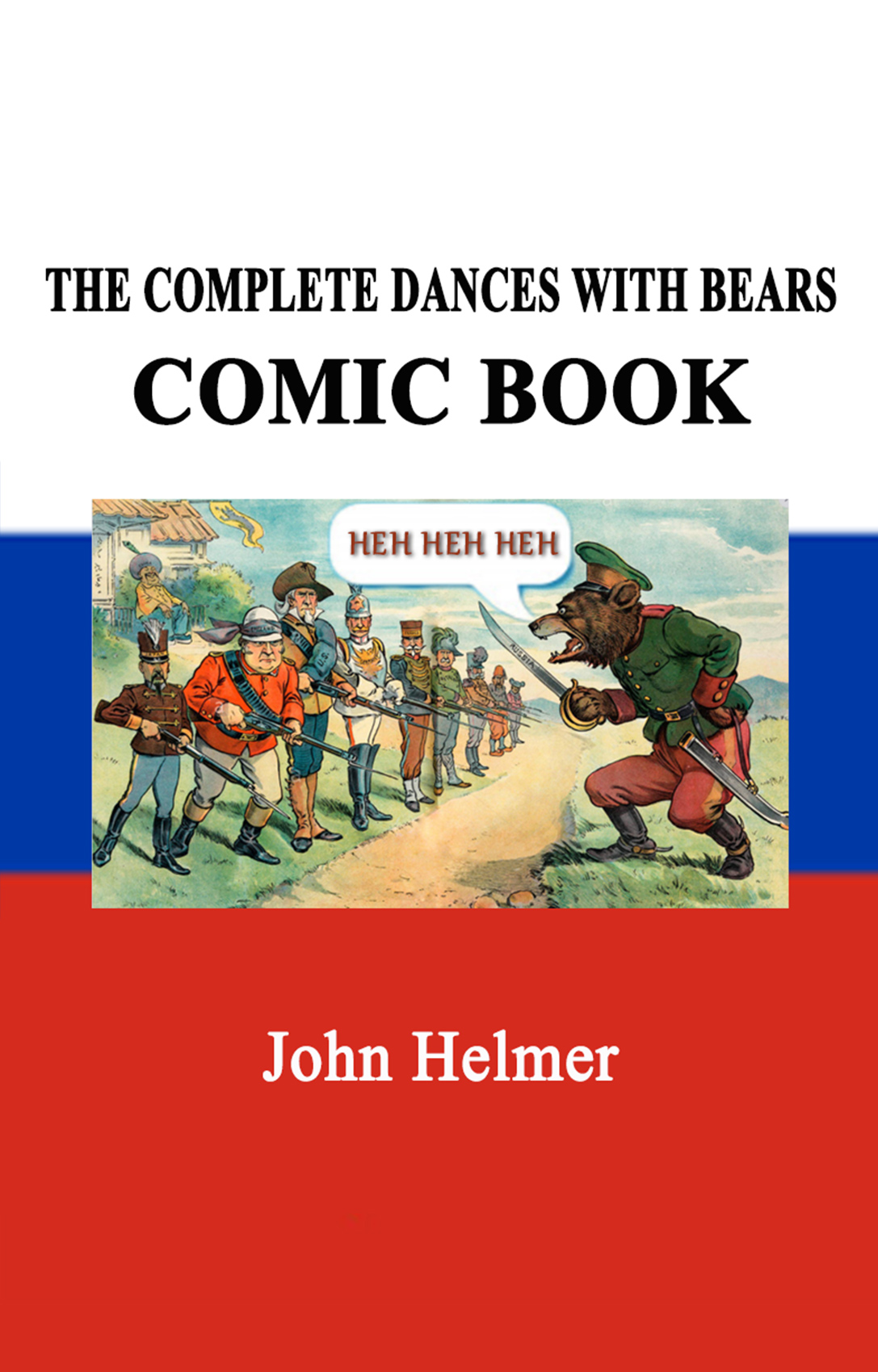
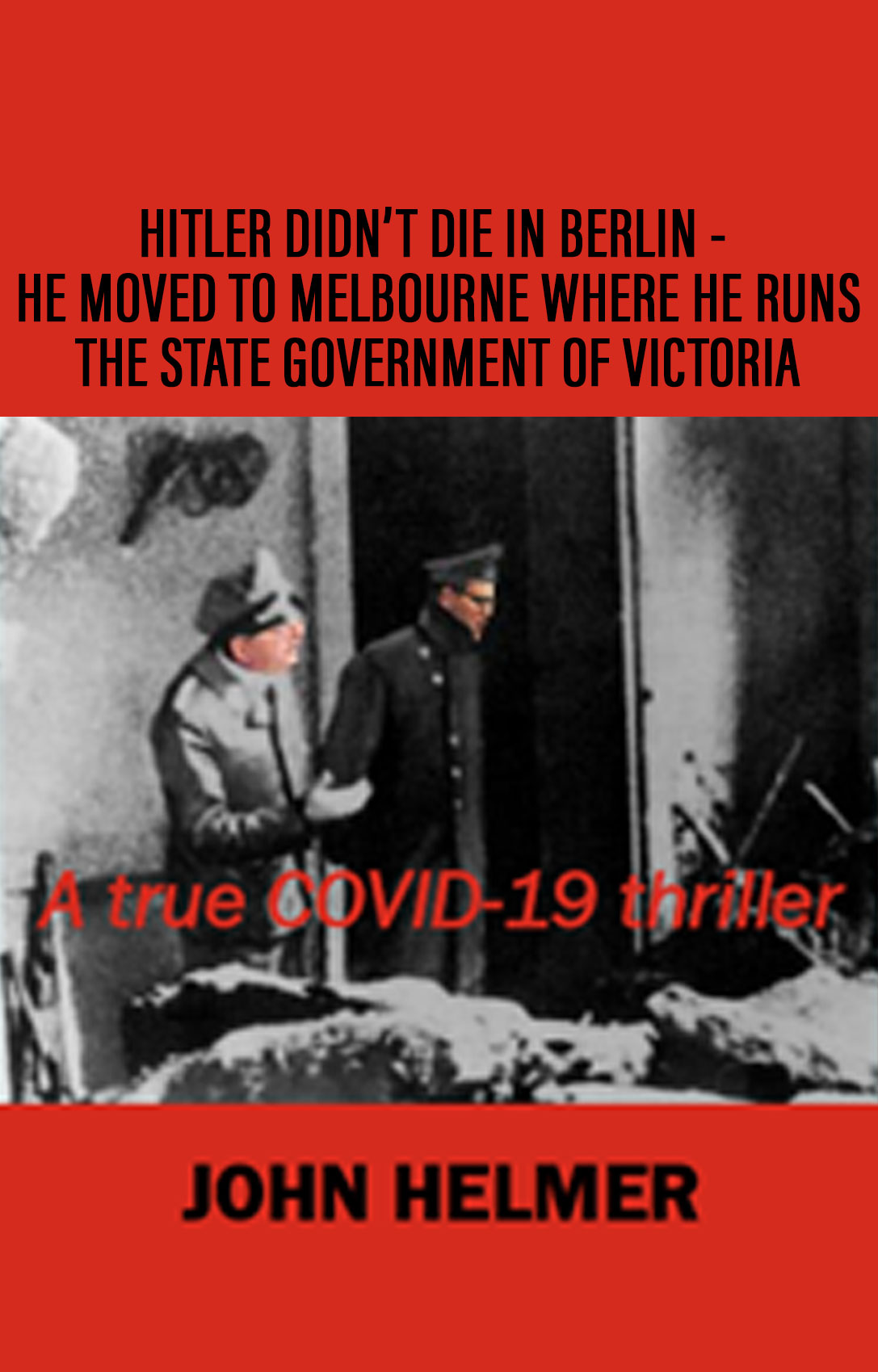
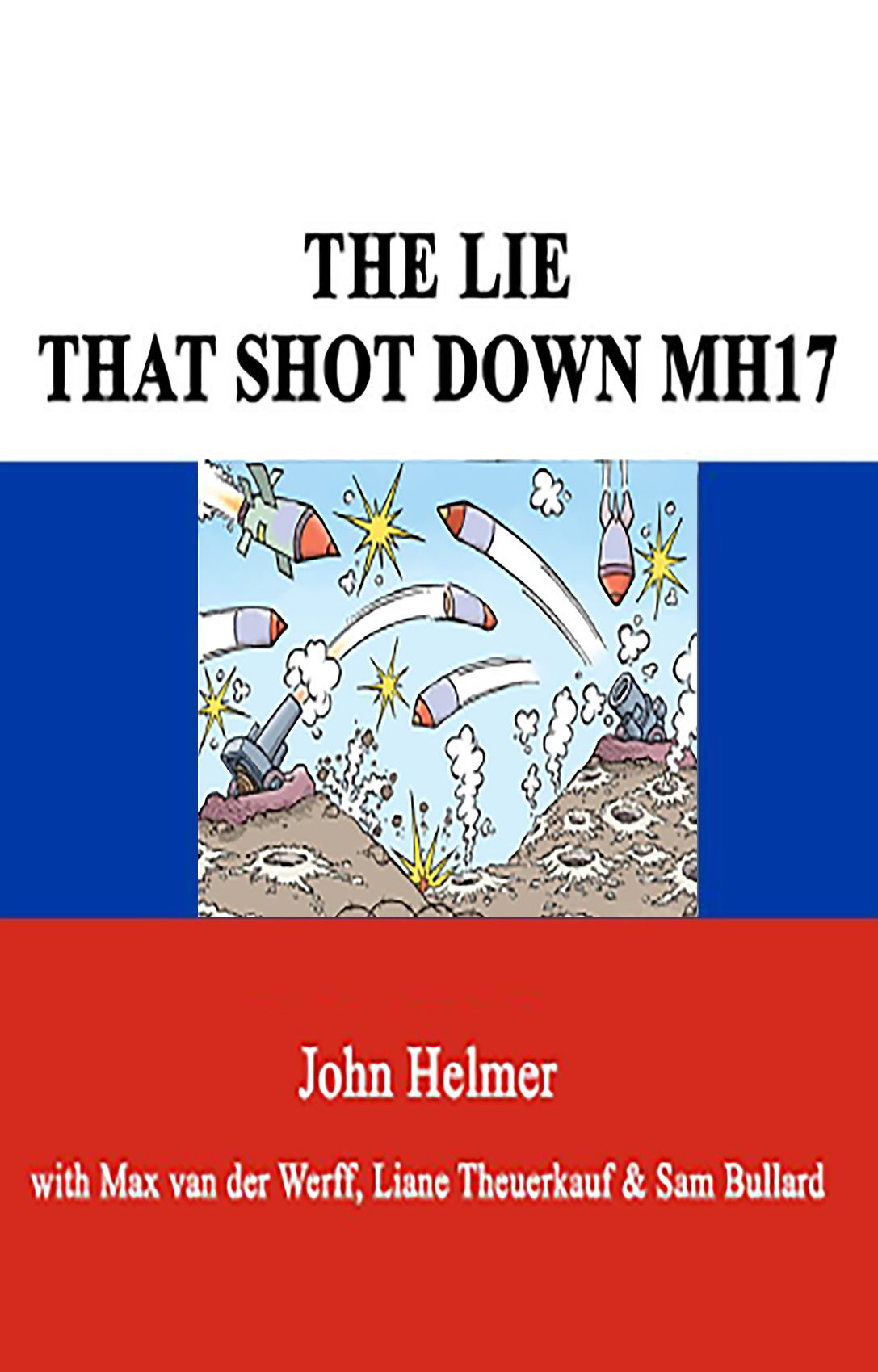
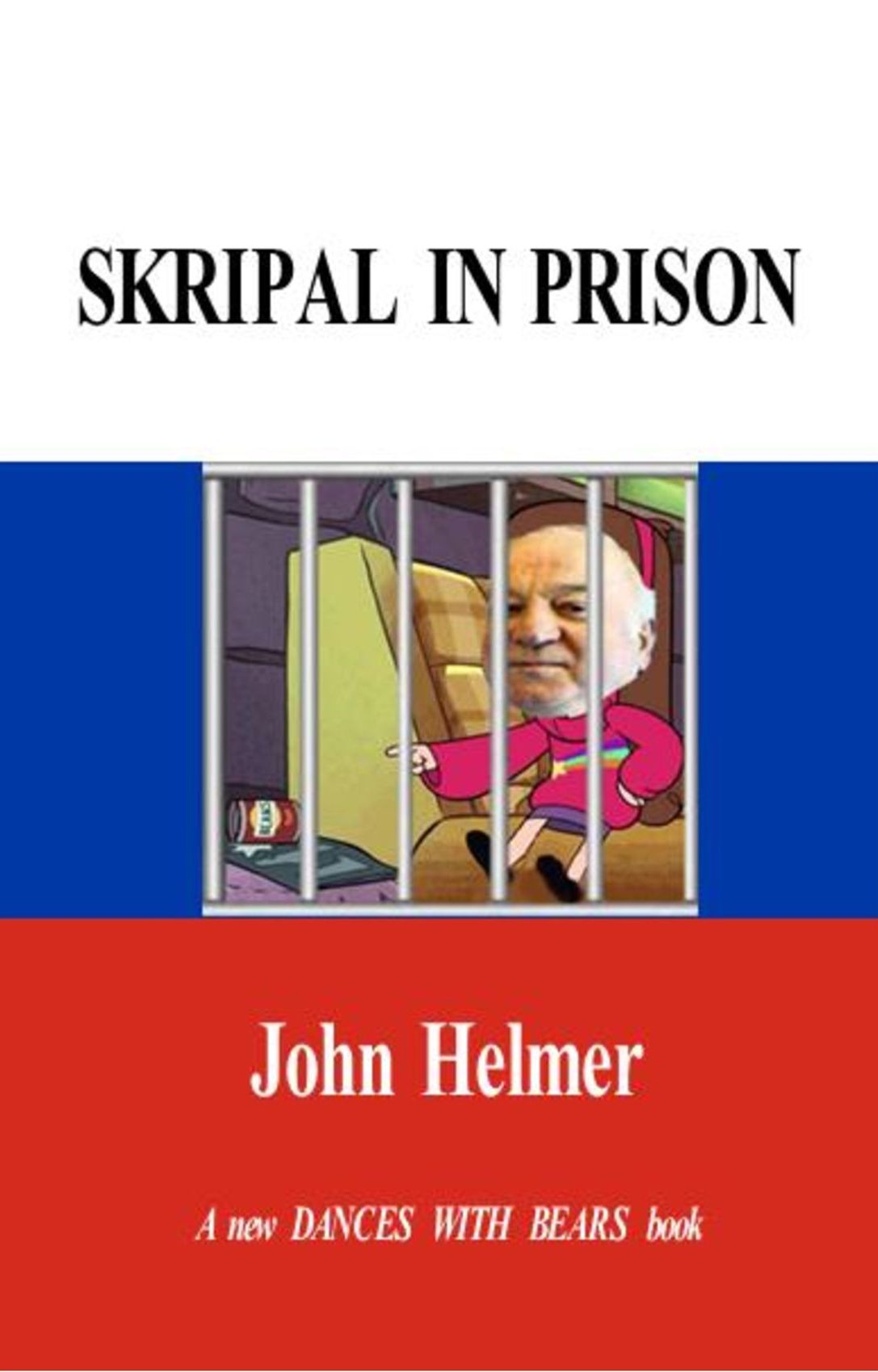
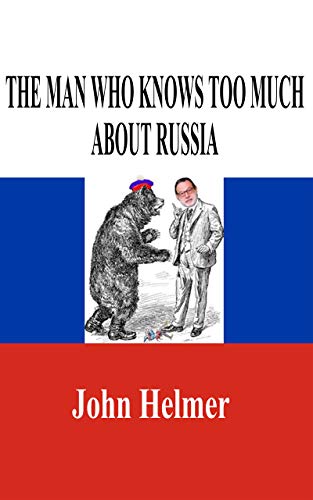
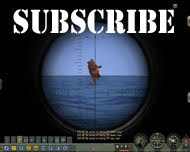
Leave a Reply